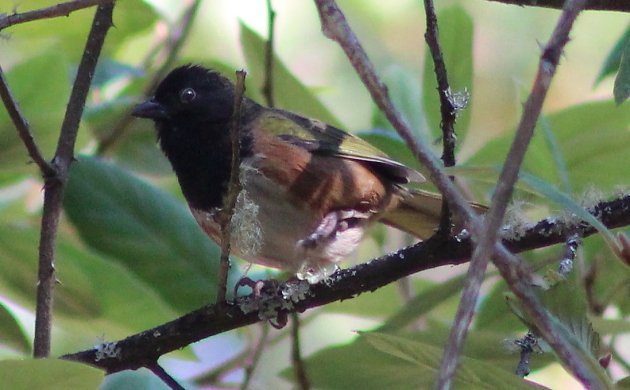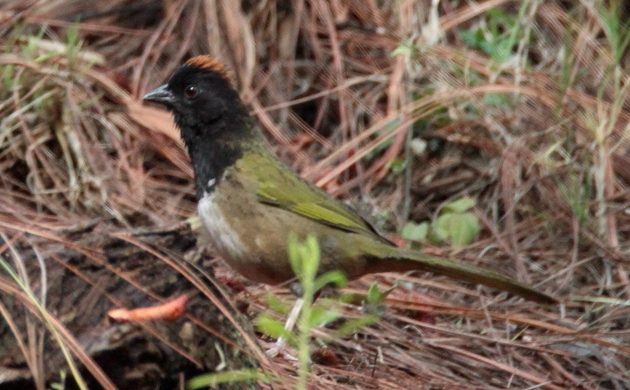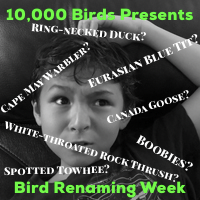
When you bird in Latin America, you quickly realize how America-centric English-language bird names are. Consider, for example, the Summer Tanager. This is an easy species for me to see in my region — any time BUT in summer. (Mexicans sometimes call it the Tangara Roja Migratoria, migratory red tanager.) The winter-only nature of migratory species can cause other name problems, such as with the Indigo Bunting. In the winter, when they visit us, these buntings are usually not indigo.
But the case of the Spotted Towhee is much more confusing, for its name problem is permanent here. This species used to be called the Rufous-sided Towhee, which was a perfectly functional name for our resident subspecies. Unfortunately, in 1995 it was split from the Eastern Towhee, and our subspecies was included in the western species, with its new name.
What is the problem? Please study the above photo, which I took a half hour from my home in Morelia, Mexico. Look carefully at those wings, and you will notice two important facts: 1) they are olive-colored, not black, and 2) NO SPOTS. But the sides are still rufous. Can you see the problem?
Now, there is a second issue to be taken into account here. In central Mexico, “Spotted” Towhees seem to hybridize freely with Collared Towhees, forming what is known as an intergrade. Some experts believe our entire resident population belongs within this intergrade. I personally almost never see clear hybrids in my area, but I do have photos of one example, with the gray flanks and rufous crown of the second species, but no collar:
 Still no spots.
Still no spots.
Dear scientists: I know Towhees are complicated. I feel your pain. Perhaps doing more DNA work in central Mexico will not produce another split; although eBird, anticipating the possibility of just such a split, suggests calling our local variety the Spotted Towhee (Olive-backed). Olive-backed Towhee would be a fine name. But if you can’t make the split, could you please find a more inclusive name for the whole species? Rufous-sided, for example, would still work perfectly.
…..
 Most birds were named by now dead white men who didn’t appreciate that most of the species they were “discovering” had already been discovered and had names. Most of the birds so named were named by men with the dead remnants of a bird in their hand and often the men doing the naming had never seen the bird in life. Geographic, honorific, horrific, and overly specific names abound much to the detriment of those who would like names to actually fit the creatures being described. And we poor birders have to use those names because otherwise no one will know what bird we are checking off our list and bragging about having spotted to fellow birders, bored families, and unimpressed romantic interests. Well, no more! We here at 10,000 Birds have decided to right some wrongs and improve the birding world by renaming birds the way they should have been named from Linnaeus to the present. (Or, at least, pointing out some names that suck.) Welcome to Bird Renaming Week, our week-long exploration of the names we put to birds and how they can be improved!
Most birds were named by now dead white men who didn’t appreciate that most of the species they were “discovering” had already been discovered and had names. Most of the birds so named were named by men with the dead remnants of a bird in their hand and often the men doing the naming had never seen the bird in life. Geographic, honorific, horrific, and overly specific names abound much to the detriment of those who would like names to actually fit the creatures being described. And we poor birders have to use those names because otherwise no one will know what bird we are checking off our list and bragging about having spotted to fellow birders, bored families, and unimpressed romantic interests. Well, no more! We here at 10,000 Birds have decided to right some wrongs and improve the birding world by renaming birds the way they should have been named from Linnaeus to the present. (Or, at least, pointing out some names that suck.) Welcome to Bird Renaming Week, our week-long exploration of the names we put to birds and how they can be improved!
…..













Paul –
I do believe the olive backed towhee in eastern Michoachan through Western Puebla is a full species…
and that hybrid Spotted-Collared Towhee occur exclusiively in Central/Western Michoachan and Eastern Puebla…
I am in the process of writing a proposal for the Olive backed Towhee
I would appreciate access to any photos of hybrids that you have taken…
Also, if you can identify the area where the hybrids are replaced by the Olive backed form… MDC
Hello Michael. I just came across your comment… I need to figure out how to keep track of comments made on my posts after they have been up for a while.
I only have one unequivocal sighting of a hybrid, from Pino Real, Michoacán, May 14 of 2018. No collar, but the rufous crown and gray flanks are unmistakeable. I have seen many, many Spotteds with no sign of hybridization, so my experience says the pure Spotted dominates everywhere within the region around Morelia. If you wish for me to send you photos, write me at paulglewis@hotmail.com with an e-mail address to which I can send them.